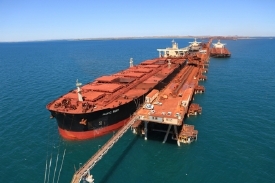Sep 8 2009
Rio Tinto has reached the historic milestone of exporting three billion tonnes of iron ore from Australia, highlighting the exponential growth of the Pilbara since its first shipment of the essential steel-making ingredient in 1966.

The three billionth tonne was loaded on to the Pacific Ruby, a Cape-size vessel berthed at Rio Tinto's recently expanded Cape Lambert port. The 240,000 tonne cargo consisted of iron ore from the Yandicoogina and Mesa J mines, and was bound for POSCO, the largest South Korean steel producer.
Rio Tinto operates 11 mines and three terminals at two ports in Western Australia's Pilbara region, and total ore exports from the Cape Lambert and Dampier ports passed the three-billion tonne mark at about mid-morning (WST) on Tuesday, 8 September.
"It is fitting that such a milestone should comprise ore drawn from the furthest reaches of our Pilbara operations, as it highlights the sheer scale and complexity of Rio Tinto's integrated production network," acting CEO and Managing Director, Pilbara mine operations, Greg Lilleyman said.
"These were two quite different products sourced from mines more than 300 kilometres apart, separately transported on two rail lines to meet at a new four-berth port for shipping to fulfil the requirements of one of our most significant long-term customers."
"The rapid, exponential growth of Rio Tinto's Pilbara operations can be gauged by the fact that we took 25 years to ship our first billion tonnes, 12 years to reach our second billion tonnes and now just six years to post our third billionth tonne."
Rio Tinto's first shipment of iron ore from Australia - 52,000 tonnes of Tom Price ore - was sent on 22 August 1966. The Huon Maru set sail from Dampier bound for Japan, for eventual steel production by Yawata Iron and Steel (Nippon Steel).
In 1972, Robe River Mining (now 53% Rio Tinto) began exporting iron ore from the newly built port at Cape Lambert, while Hamersley Iron (100% Rio Tinto) opened its second port terminal in Dampier later that year.
In 2009, Rio Tinto plans to export 200 million tonnes of iron ore, virtually all of it from the Pilbara, compared with the then-impressive total of 761,000 tonnes exported in 1966.
Posted on September 8th, 2009